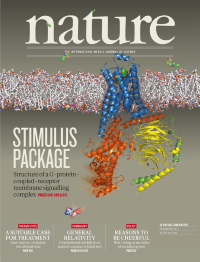Volume 477
-
No. 7366 29 September 2011
G-protein-coupled receptors (GPCRs) mediate the majority of a cells responses to hormones and neurotransmitters, and to the senses of sight, olfaction and taste. This makes GPCRs potentially the most important group of drug targets in the human body. GPCRs are deeply embedded in the cell membrane, crossing it seven times, so structure determination for these complexes is particularly challenging — as recounted in a recent News Feature (see go.nature.com/ftqnx4). The eagerly-awaited X-ray crystal structure of a GPCR transmembrane signalling complex has now been determined by Brian Kobilkas group, and the paper is published in its final form in this issue. The structure presented is of an agonist-occupied monomer of the β2 adrenergic receptor in complex with Gs, the stimulatory G protein for adenylyl cyclase. An accompanying paper reports the use of peptide amide hydrogen-deuterium exchange mass spectrometry to probe the protein dynamics of this signalling complex.
-
No. 7365 22 September 2011
The military has for many years been one of the biggest investors in scientific research. The fruits of its spending are clear to see in ever more sophisticated weapons of offence and defence. But many advances based on military research have found their way into everyday, peaceful use. In this issue of Nature, we examine the achievements, deficiencies and ethics of all aspects of military research.
-
No. 7364 15 September 2011
On 6 April 2009, the Abruzzo region of central Italy was struck by a 6.3-magnitude earthquake, causing serious damage to several medieval hill towns. More than 300 people lost their lives, around 1,500 were injured and 65,000 were made temporarily homeless. Earlier this year, six scientists and a government official were charged with manslaughter for failing to evaluate and communicate the potential risks. They are due to go on trial in L'Aquila on 20 September. In a News Feature, Stephen S. Hall tells how the local community came to feel betrayed by science. Cover: Franco Origlia/Getty.
Collection
-
No. 7363 8 September 2011
The toxic butterfly Heliconius numata, found in forests across South America, mimics the wing patterns of several species of another family of toxic butterflies, Melinaea sp., in order to deter predators more effectively. This example of M�lerian mimicry is under the control of a classic supergene, a tight gene cluster usually inherited as a single unit. H. numata is particularly adept at mimicry, able to copy as many as seven different wing patterns. A study of the individual wing-pattern morphs in H. numata shows that different genomic rearrangements at the single supergene P locus tighten the genetic linkage between loci that are otherwise free to recombine in other closely related species. The resulting supergene acts as a simple switch that, once thrown, selects which one of a range of complex adaptive phenotypes the butterfly displays. The cover shows Heliconius numata (top) and Melinaea mneme, from French Guiana. Photo: Mathieu Chouteau.
-
No. 7362 1 September 2011
The earliest known stone tools are simple flakes chipped roughly from a core, called the Oldowan tradition. The more advanced Acheulian culture followed, characterized by leaf-shaped bifaces or hand axes. The Acheulian is thought of as the signature technology of Homo erectus. The timing of the emergence of the Acheulian remains unclear because well-dated sites older than 1.4 million years are scarce. A new stratigraphic study at the Kokiselei archaeological site in West Turkana in Kenya, where both Oldowan and Acheulian tools are found, has yielded the worlds oldest Acheulian stone tools, dating to 1.76 million years old 350,000 years older than the previous earliest-known record of Acheulian artefacts. As the first records of hominins outside Africa include either no tools or only Oldowan-type tools, the research also suggests that the first Eurasian hominins to have left Africa might not have taken Acheulian culture with them. On the cover, a large crude handaxe (KS4-203) shaped by hard hammer percussion from a flat phonolite pebble (P.-J. Texier/MPK/WTAP).





